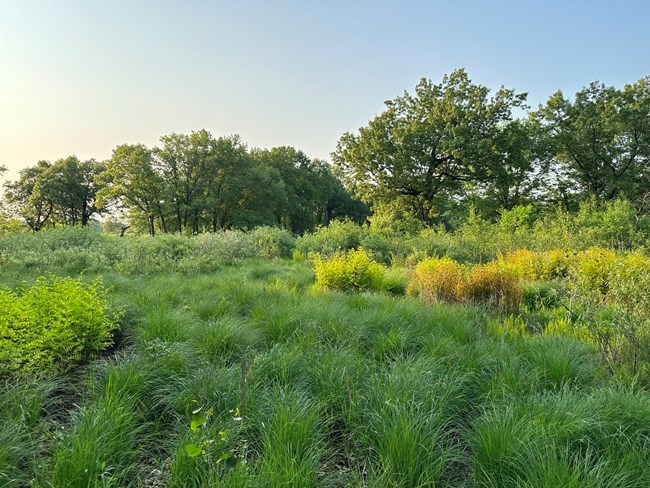
Plant diversity is exceptionally high here due to a wide range of moisture conditions. Sand rises support dry black oak savannas. Mesic sand prairie openings can be found on slopes between the rises and swales. Wet prairies, sedge meadows and marshes are scattered throughout the preserve in depressions and flats. Its size and plant diversity make Hoosier Prairie an excellent place to see native birds and other animals in their natural surroundings. Many of these animals are now rare in Indiana due to the disappearance of their native habitats. Prior to European settlement, fire was a normal part of prairie ecosystems. Fire killed the forest trees, but prairie plants were adapted to frequent fires and survived. When settlers suppressed wild fires, woody plants invaded the prairie. Now carefully controlled fires are used to maintain the prairie as it was before settlement.
Hoosier Prairie Trails offer a glimpse of part of Indiana's original landscape. Dedicated as both a State Nature Preserve and a National Natural Landmark in 1977, Hoosier Prairie in Lake County hosts a surprising and stunning array of prairie plants and great ecological diversity amidst the industry of Northwest Indiana. The rolling topography and sandy soils create a variety of habitats that support more than 350 native species of plants, at least 43 of which are uncommon or rarely seen in the state, such as wild white indigo. Hoosier Prairie's landforms represent the oldest relic shoreline in the park. Sands accumulated here around 13,000 years ago as part of the Glenwood Spit, an extension of Glenwood Dunes found over twenty miles away to the northeast. From a core of about 300 acres, the patchwork Hoosier Prairie unit has grown to protect over 1,500 acres. Although this unit is within the authorized boundaries of the national park, aside from Gaylord Butterfly Prairie, most of Hoosier Prairie is owned managed by Indiana's Department of Natural Resources. Trail Features: Birding, Fall Colors, Views, Wildflowers and Wildlife Getting ThereHoosier Prairie Parking Lot Need to KnowHours & Information
Safety
Accessibility
Trail MapClick here for a list of all maps of the Indiana Dunes National Park. 
Hoosier Prairie Trail Map
Featured Hikes Hoosier Prarie Trail 0.7 miles Hike time: 0.5-1 hours This featured hike begins as a 0.15 mile crushed gravel trail accessible to wheelchairs. The Prairie Marsh Trail segment (0.25 mile) begins at the end of this gravel straightaway. This loop has a spur that leads to a final loop known as the Savanna Trail segment (0.3 miles). The trail winds through oak savanna, prairie, and wetland habitats. History and Background The area was saved from development largely due to efforts of Irene Herlocker-Meyer, who for 10 years led the charge in one of the state's most politically-difficult preservation battles. Nearby HikesHobart Prairie Grove Trails Photos
Joseph Gruzalski 
Joseph Gruzalski |
Last updated: November 13, 2024
